Difference between revisions of "1,2-Dichloroethane"
| Line 136: | Line 136: | ||
===Disposal=== | ===Disposal=== | ||
| − | Dichloroethane can be neutralized with a | + | Dichloroethane can be neutralized by reducing it with a metal over the course of several days or with Fenton's reagent. Both processes release heat, which may volatilize some dichloroethane. This should be performed in a fumehood or outside. |
==References== | ==References== | ||
Revision as of 17:09, 11 October 2018
 Structure of 1,2-dichloroethane
| |
| Names | |
|---|---|
| IUPAC name
1,2-Dichloroethane
| |
| Other names
DCA
DCE Dutch liquid Dutch oil Ethane dichloride Ethylene dichloride Freon 150 | |
| Properties | |
| C2H4Cl2 | |
| Molar mass | 98.954 g/mol |
| Appearance | Colorless liquid |
| Odor | Chloroform-like |
| Density | 1.253 g/cm3 |
| Melting point | −35 °C (−31 °F; 238 K) |
| Boiling point | 84 °C (183 °F; 357 K) |
| 0.87 g/100 ml (20 °C) | |
| Solubility | Miscible with alcohols, ethers, ketones |
| Hazards | |
| Safety data sheet | Sigma-Aldrich |
| Flash point | 13 °C (55 °F; 286 K) |
| Lethal dose or concentration (LD, LC): | |
| LC50 (Median concentration)
|
3,000 ppm (guinea pig, 7 hr) 1,000 ppm (rat, 7 hr) |
| Related compounds | |
| Related compounds
|
Dichloromethane |
| Except where otherwise noted, data are given for materials in their standard state (at 25 °C [77 °F], 100 kPa). | |
| Infobox references | |
1,2-dichloroethane, or ethylene dichloride, is a common solvent and reagent, going by the abbreviations EDC and 1,2-DCA. It is also used to make vinyl chloride, the major precursor to polyvinyl chloride, commonly known as PVC.
Contents
Properties
Chemical
Ethylene dichloride is a slightly reactive polar solvent. It is sometimes used as a precursor to ethylenediamine and 1,1,1-trichloroethane[1].
Physical
Ethylene dichloride is colorless and has a high index of refraction, giving it a shiny appearance, similar to chloroform, which it also shares a similar smells. It is a versatile solvent, though it does form azeotropes with water and many other solvents.
Availability
1,2-Dichloroethane is mostly bought from chemical suppliers rather than ordinary retail stores due to its inherent dangers. In some countries, however, it is sold in hobby stores with no questions asked as a solvent for fusing plastic parts to each other, most often mixed with various hydrocarbons.
Preparation
1,2-Dichloroethane can be prepared by bubbling chlorine through ethylene solution (e.g. dissolved in carbon tetrachloride) with a iron(III) chloride catalyst, or bubbling oxygen through a solution of 1 molar part ethylene to four molar parts hydrochloric acid with a copper(II) chloride catalyst. The first procedure produces pure 1,2-dichloroethane, while the second results in water as well[2].
Projects
- Ethylenediamine synthesis
- Make PVC
Handling
Safety
Ethylene dichloride is toxic (by inhalation), flammable, and a carcinogen. All these hazards are amplified by the chemical's volatile nature. This chemical is also unstable when in the presence of aluminium, zinc, and iron[3].
Storage
Dichloroethane should be stored in closed bottles in dark well ventilated places.
Disposal
Dichloroethane can be neutralized by reducing it with a metal over the course of several days or with Fenton's reagent. Both processes release heat, which may volatilize some dichloroethane. This should be performed in a fumehood or outside.
References
- ↑ http://en.wikipedia.org/wiki/1,2-Dichloroethane
- ↑ http://en.wikipedia.org/wiki/1,2-Dichloroethane
- ↑ http://en.wikipedia.org/wiki/1,2-Dichloroethane